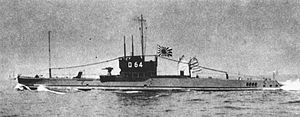 RO-64 in 1945
| |
| History | |
|---|---|
| Name | Submarine No. 79 |
| Builder | Mitsubishi, Kobe, Japan |
| Laid down | 15 October 1923 |
| Launched | 19 August 1924 |
| Renamed | Ro-64 on 1 November 1924 |
| Completed | 30 April 1925 |
| Commissioned | 30 April 1925 |
| Decommissioned | 10 December 1928 |
| Recommissioned | 1 December 1929 |
| Decommissioned | 1 December 1932 |
| Recommissioned | 25 March 1933 |
| Decommissioned | 1 December 1936 (possibly — see text) |
| Recommissioned | 1 May 1939 (possibly — see text) |
| Decommissioned | 20 March 1940 |
| Recommissioned | 26 July 1940 |
| Fate | Sunk 12 April 1945 |
| Stricken | 10 August 1945 |
| General characteristics | |
| Class and type | Type L4 (Ro-60-class) |
| Displacement | |
| Length | 78.39 m (257.2 ft) |
| Beam | 7.41 m (24.3 ft) |
| Draft | 3.96 m (13.0 ft) |
| Propulsion | 2 × Vickers diesels, 2 shafts 2,400 bhp (surfaced), 1,600 (submerged) |
| Speed |
|
| Range |
|
| Test depth | 60 m (200 ft) |
| Complement | 48 |
| Armament |
|
Ro-64, originally named Submarine No. 79, was an Imperial Japanese Navy Type L submarine of the L4 subclass. First commissioned in 1925, she served in the waters of Japan and Chōsen prior to World War II. During World War II, she operated in the Central Pacific, supported the Japanese invasion of Rabaul, and took part in the Aleutian Islands campaign, then in late 1942 was relegated to a role as a training ship. She was sunk in April 1945.